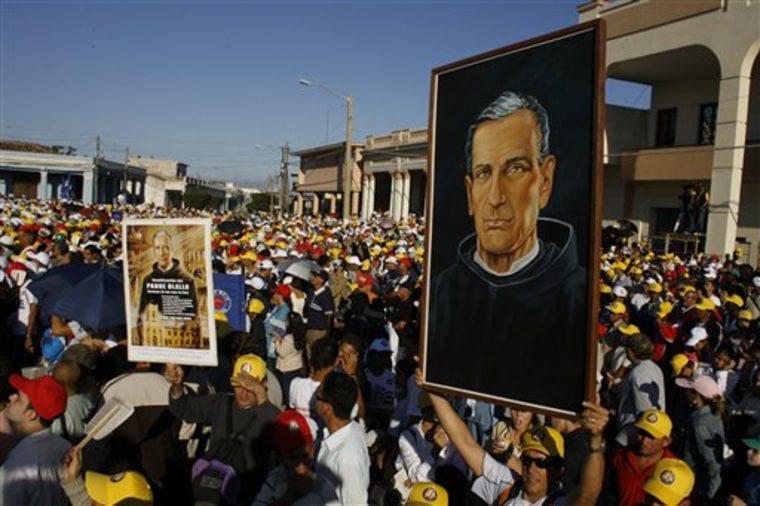Thousands of Roman Catholic faithful and even President Raul Castro gathered Saturday for the beatification of a monk known as the "father of the poor" — the first ceremony of its kind on Cuban soil.
The act brings Friar Jose Olallo Valdes, a member of the Hospitaller Order of St. John of God, to within one step of sainthood.
Olallo was born in 1820 and abandoned at a Havana orphanage. He came to the central city of Camaguey to take his religious vows at 15 and stayed the rest of his life, earning his nickname by caring for the needy and chronically ill. He died in 1889 at age 69.
Beatification declares a departed person's ability to intercede on the part of the faithful who pray to him. Olallo is credited with a miracle in 1999, when a 3-year-old girl with an abdominal tumor made an unlikely recovery after her family prayed to him for help.
The girl, Daniela Cabrera Ramos, now 12, attended the ceremony and told The Associated Press, "I am happy. He gave me happiness and strength. He gave me a miracle and I think he can do it for many children or people who are sick."
Cabrera's mother, Yamila Ramos, broke down in tears.
"Daniela had terminal, very aggressive cancer," said the 45-year-old economist.
Authorities erected a large, open-air cathedral in Camaguey's Plaza de la Caridad and Cuba's 77-year-old president made a previously unannounced appearance, wearing a gray suit and taking a seat in the front row.
The beatification and Raul Castro's attendance could help further improve the once icy relationship between the church and Cuba's communist government.
The single-party, communist government never outlawed religion but expelled priests and closed religious schools when Fidel Castro took power in January 1959.
Pope Benedict XVI released a statement saying he hoped Olallo's beatification will "give renewed apostolic vitality" to religious Cubans.
Tensions eased between Cuba and the church in the early 1990s when the government removed references to atheism in the constitution and let believers of all faiths join the Communist Party. They warmed more when Pope John Paul II visited in 1998.
Jose Saraiva, prefect emeritus of the Congregation for the Causes of Saints, the Vatican's saint-making office, traveled to Cuba from Rome for the ceremony.
"In the face of a materialist culture that we see imposing itself everywhere and that pushes aside the weak and the poor, we learn from Olallo the virtues of the wisdom of God and how to love thy neighbor universally," Saraiva said.
Officials released a collection of doves and rang church bells, ending the ceremony with a procession through the city of Camaguey bearing Olallo's remains in a gold-colored earn.
The Cuban Roman Catholic Church started the process of beatifying Olallo in 1989, the 100th anniversary of his death. His is the first beatification in Cuba, but he is not the first Cuban to be beatified.
Cuban-born, Augustinian deacon Jose Lopez Piteira was beatified in Rome last year. He did most of his work in Spain, where he was shot in 1936 during the civil war.
